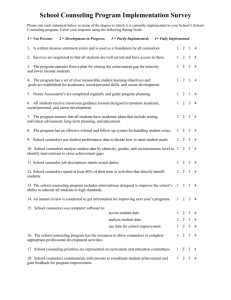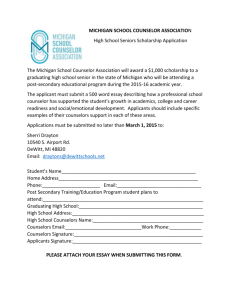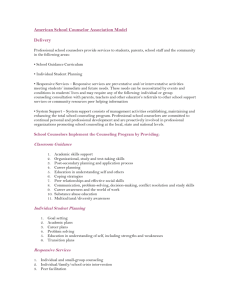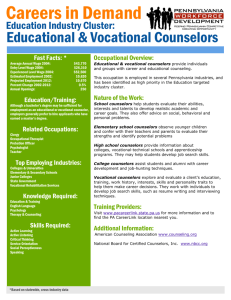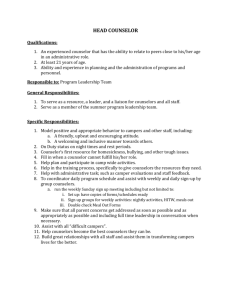By 2008 - MASCA Massachusetts School Counselors Association
advertisement
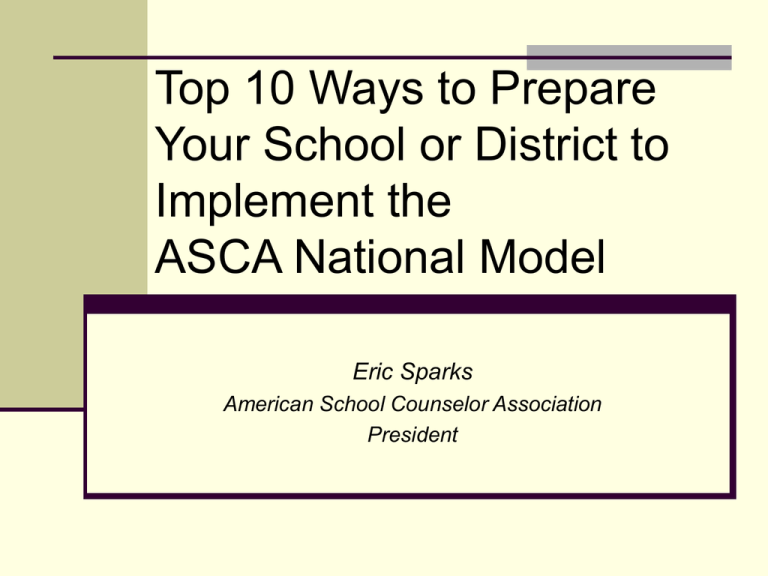
Top 10 Ways to Prepare Your School or District to Implement the ASCA National Model Eric Sparks American School Counselor Association President WCPSS Implementation 134,000 students 147 schools district wide 320 School Counselors 13. Present the National Model to Stakeholders to get Buy-In Principals Superintendent/Asst Superintendent Curriculum and Instruction Admin PTA Faculty Meeting School Counselors How are students different as a result of the school counseling program? 12. Connect with school/district goals and plans School Improvement Plans District Goals State Goals WCPSS Goal 2008 By 2008: 95% of students in grades 3 through 12 will be at or above grade level as measured by NC EOG or EOC tests All student groups will demonstrate high growth 1 goal for entire district! 11. Provide Appropriate Training Great for teambuilding! Foundation Action Plans Use a team approach Social Workers Psychologists Nurses Administrators Career Development Coordinators Instructional Resource Teachers Intervention Coordinators More About Training . . . Provide time away from school to train and develop plans Follow up with work sessions throughout the school year for a booster shot May need to supplement with activities specific to your needs 10. Understand Measurable Goals and Objectives Counselors may have difficulty writing clear action plans Goals are broad statements that describe expected outcomes Objectives are are clear, realistic, measurable and time-limited statements of actions which, when completed, will move towards goal achievement Writing Goals and Objectives for Action Plans Choose a reasonable number of action plans All school counseling goals should be written in the terms of improving: Academics Behavior Attendance Strategies are counseling strategies, and fit within the activities in the Delivery System Example of Goals and Objectives Area Goal Objective Academic To increase number of promotions In 06-07, the promotion rate of 3rd grade students will increase by 10% as compared to 05-06 Behavior To create a safer school climate In 06-07, incidents of fighting at school will be reduced by 5% as compared to 05-06 Attendance To increase the attendance rate In 06-07, the attendance rate of 9th grade repeating students will increase by 50% 9. Define “At-Risk” How do you define “at-risk”? How does NCLB define “at-risk”? Define “At-Risk” Big 3 Academics Behavior Attendance WCPSS Academic Risk Factors for High School 1. Below Grade Level (8th) 1. Math 2. Reading 2. Competency Not Met 1. Math 2. Reading 4. Below grade level any of 5 End of Course Tests 5. F in one course last year 6. F in more than one course last year 7. Retained last year 3. F on Computer Competency 8. Data, Data, Data May be the most difficult piece for counselors Counselors must interpret data collect data get comfortable with data Not turning counselors into statisticians or researchers Student Information Given To Counselors Student Information Given To Counselors 7. Collaborate on Data Data may be difficult to get – it is “confidential” Determine who has the data School level District level State level Find out what data is available Can they make it simple to use? Getting Comfortable with Data Phase I Learning to use data, technology, to target students Phase II Identifying effective practices Phase III Asking questions that can be answered with data Phase II: Identifying Effective Practices • Increased minority enrollment in AP courses • Fewer suspensions • More ESL parent participation at conferences • Increased test scores • Documentation and evidence of success has clarified their roles • Teachers have begun to make students more accessible for services Phase III: Asking Questions Are there variables that can predict who is likely to drop out as 9th graders? Can we use this data to identify effective practices for serving these students? Can we identify students to target for interventions who are likely to drop out as 9th graders? Identify Effective Practices for Serving Students Predicted to Dropout in 9th Grade Data shows: At one high school, 6% of students with one of these risk factors dropped out; At another high school, nearly 25% of students with one of these risk factors dropped out. What is the difference? What programs did these students participate in? How can you reduce the number of students with these risk factors? Increase success in Algebra: Research shows that success in algebra varies for high average (C+) students, based on 8th grade math placement--%s of C+ students who pass 2 college prep math classes: 2% of those placed in low track 23% of those placed in average track 91% of those placed in top track High achieving White students are 3 times as likely to be tracked into top classes, compared with equivalent minority students. Burris, Heubert, & Levin (2006). Accelerating mathematics achievement using heterogeneous grouping. American Educational Research Journal, 43(1), pp. 105-136. 6. Determine what services are available in your school–district–community Large schools offer many services Who knows all of the services? Counselors Social Workers–Nurses–Psychologists Teachers Administrators Parents Students How do you let students and parents know about these services? The power of resource lists Resource Checklist 5. Focus on Leadership, Advocacy, Collaboration Need 1 person with a vision You’re here (This is you!) Expect difficult questions Answer questions within these categories (leadership, advocacy, collaboration) All lead to Systemic Change 4. Develop a Long-Range Plan Be clear about your vision Create a 3-5 year implementation plan Divide model into manageable chunks Start wherever it makes the most sense for your district Remember … accountability takes time WCPSS Recognition (Implementation Plan) ¼ carat ½ carat ¾ carat Full carat! (RAMP Ready) What Level 1 (1/4 carat) Schools Do . . . Beginning of Year (by Nov. 9) Calendar (Including Suicide Prevention Activities MS & HS) Action Plans Management Agreement Resource Checklist End of the Year (by June 15) Results Report (year end) Results Over Time 3. Accept the “Yeah, buts . . .” Learn from “probletunities*” Not everyone will embrace the model Improve from their questions– comments–complaints Acknowledge issues Won’t solve all the issues in one year Look for solutions Keep Moving! * from David Langford 2. Find Your Sardines! Some school counselors and administrators will buy in immediately Only need 20% to get going Start with volunteers Blue Whales Blue whales take 3-5 minutes to turn 180 degrees Committed Sardines from Doug Manning If 15 – 20 % commit to a direction, all others will turn and go with them almost instantaneously! Critical Mass! 1. The number one way to prepare your school or district to implement the ASCA National Model … Aren’t School Counselors Amazing®? Contact Information Eric Sparks American School Counselor Association President Wake County Public School System 919.858.1708 ericsparks4@aol.com

